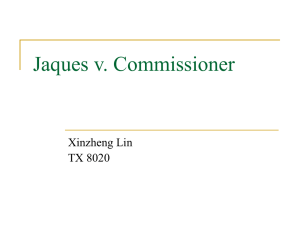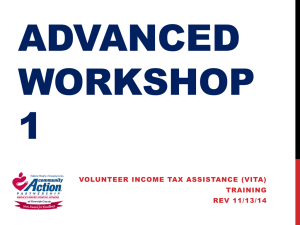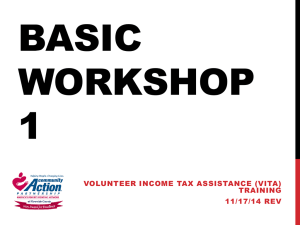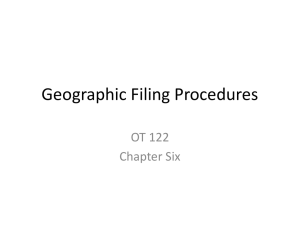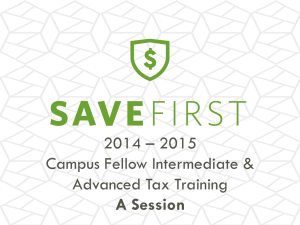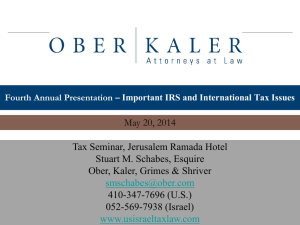Volunteer Advanced Training 2
advertisement
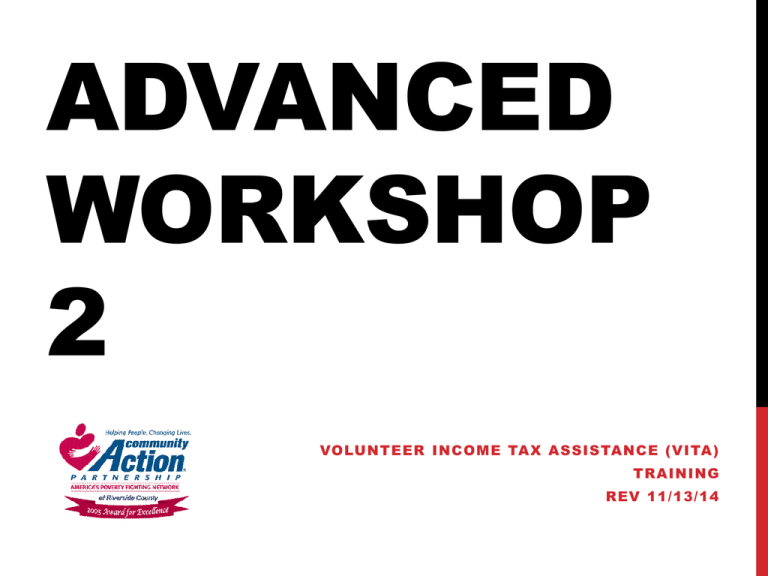
ADVANCED WORKSHOP 2 VOLUNTEER INCOME TAX ASSISTANCE (VITA) TRAINING REV 11/13/14 RECAP What we covered last week: • History • Volunteer • Annuities/Pensions/IRA • Itemizations • Schedule C – Business Income TODAY What we will cover: • Credits • • EITC • Residential Energy • Foreign • American Opportunity • Lifetime Learning Schedule D • Capital Gains/Loss • • • Short Term Long Term Schedule E • • Royalties K-1 TAX PREPARATION Earned Income Tax Credit To qualify for Earned Income Tax Credit or EITC, you, and your spouse if married and filing a joint return, must meet all of the following rules: Have a Social Security Number that is valid for employment Have earned income from working for someone, running or owning a business or farm or another source Cannot file as married filing separate Must be: • a U.S. citizen or resident alien all year or • a nonresident alien married to a U.S. citizen or resident alien, file a joint return and choose to be treated as a resident alien (for more information on making this choice, see Publication 519, U.S. Tax Guide for Aliens) Cannot be the qualifying child of another person Cannot file Form 2555 or 2555-EZ (related to foreign earned income) Your Adjusted Gross Income and earned income must meet the limits shown on the Income Limits, Maximum Credit Amounts and Tax Law Updates Page Your investment income must meet or be less than the amount listed on the Income Limits, Maximum Credit Amounts and Tax Law Updates Page TAX PREPARATION Earned Income Tax Credit TAX PREPARATION Earned Income Tax Credit Test 1. 2. A taxpayer has interest income of $3,500. His job pays him $7,000 annually. He is 30, single, has a valid social security number and is not the qualifying child of anyone else, does he qualify? Starting in February of the tax year, Sam has cared for Lisa in his home. She is the 10 year old daughter of his stepson who also lives with him and is unemployed. Does Lisa meet the EITC requirements for a qualifying child? TAX PREPARATION Earned Income Tax Credit Read the directions, if you answer 4a with a yes, then move to Line 5. TAX PREPARATION Earned Income Tax Credit • Answer each question carefully and accurately. TAX PREPARATION Earned Income Tax Credit This is the tricky portion to the EIC worksheet, be sure to read each line and answer accordingly. Complete each column where a qualifying child is listed. TAX PREPARATION Earned Income Tax Credit Ask taxpayer if they have ever been disallowed for the tax credit. Most questions are prefilled, but Question 13 asks about residency. If taxpayer has lived in United States for more than half the year, answer, Yes. RESIDENTIAL ENERGY CREDIT • For tax years after 2005, the total combined credit limit is $500, and the combined credit limit for windows is $200 (Form 5695, Part I). • The maximum credit for residential energy property costs is $50 for any advanced main air circulating fan; $150 for any qualified natural gas, propane, or oil furnace, or hot water boiler; and $300 for any item of energy-efficient building property. The energy-efficiency standards for qualified natural gas, propane, or oil furnaces, and hot water boilers have increased. FOREIGN TAX CREDIT Credit applies to those who have paid tax to a foreign country • Link to Form 1116 from Form 1040 • Can enter directly on 1040 page 2 if the foreign tax is less than $300 Single/$600 Married Filing Jointly, is from passive income, and is reported in box 6 of their 1099-INT or 1099-DIV • If the foreign tax is not passive and/or is greater than the election limits, refer to a professional tax preparer (out-ofscope for VITA) AMERICAN OPPORTUNITY CREDIT • Who is eligible • Taxpayer, spouse, or eligible dependent claimed on the tax return • Attended qualified post -secondary educational institute (college, university, or vocational school) at least half time • Cannot be married filing separately, and cannot be claimed as a dependent on anyone else’s return • Expenses that qualify • • • • Tuition (Form 1098-T) Activity fees if required of all students Books and supplies Subtract tax-free assistance (scholarships & grants) AMERICAN OPPORTUNITY CREDIT • Who is eligible • Taxpayer, spouse, or eligible dependent claimed on the tax return • Attended qualified post -secondary educational institute (college, university, or vocational school) at least half time • Cannot be married filing separately, and cannot be claimed as a dependent on anyone else’s return • Expenses that qualify • • • • Tuition (Form 1098-T) Activity fees if required of all students Books and supplies Subtract tax-free assistance (scholarships & grants) LIFETIME LEARNING CREDIT •No limit to the number of years credit can be claimed •Course-related books, supplies, fees, and equipment are included in qualified educational expense ONLY if the fees and expenses must be paid to the institution as a condition of enrollment •No portion of the credit is refundable WHICH CREDIT? Question 1: Bob is a full-time student and is a fifth-year senior. Does he qualify for the American opportunity credit? □ Yes □ No Question 2: Janice works full time and takes one course a month at night school. Some of the courses are not for credit, but they are meant to advance her career. Which credit is appropriate for her? □ American opportunity □ Lifetime Question 3: Clark is an older student who has gone back to college half time after serving 18 months in prison for felony drug possession. Which credit is appropriate for him? □ American opportunity □ Lifetime QUESTIONS TAX PREPARATION (SCH D) Capital Gains and Losses: • Proceeds from Sale – Gross or net proceeds from the sale of stock or mutual fund is reported to taxpayer on Form 1099 B or on a 1099 Consolidated Statement • How to record on Schedule D ?– First need to determine the “basis” and the “holding period” TAX PREPARATION (SCH D) Capital Gains and Losses: TAX PREPARATION (SCH D) Capital Gains and Losses: • Original cost of the asset, adjusted for commissions • The basis for stock received as a gift or inheritance is Fair Market Value at the time it was received by taxpayer • If the taxpayer cannot provide the basis, the IRS will assume $0 • Dividends of stock in lieu of cash increase taxpayer’s ownership so original basis is spread over more shares…thus reducing effective basis • Stock splits reduce original basis (e.g. 2 for 1 = 50%) TAX PREPARATION (SCH D) EXAMPLE: Alice paid $1,100 for 100 shares of ABC, Inc. stock (which included the broker’s commission of $25). The original basis per share was $11 ($1,100 ÷ 100). She received 10 additional shares as a tax-free stock dividend. Her $1,100 basis must be allocated to the 110 shares (100 original shares plus the 10share stock dividend). This results in an adjusted basis of $10 per share ($1,100 ÷ 110). TAX PREPARATION (SCH D) • Short-term property is held one year or less • Long-term property is held more than one year, and is taxed at a lower rate that short term gains • Inherited stock is always treated as long-term property • Using cash dividends to purchase additional shares of stock simply adds new stock with it’s own separate basis and holding period TAX PREPARATION (SCH D) • Repeal of estate tax for decedents dying after 12/31/2009 and before 1/1/2011 • Automatic long term holding period does not apply to inherited stock • If taxpayer sells property inherited from someone who died in 2010, refer the taxpayer to a professional tax preparer TAX PREPARATION (SCH D) How to Report: • Reported to taxpayer on Form 1099-B or on a Consolidated Statement • Form 1099-S usually reflects gross proceeds of real estate transactions Enter on a Schedule D • If box 5, 10, 11,12, 13, or 14 has an entry, refer the taxpayer to a professional tax preparer. These boxes provide information about wash sales, regulated futures contracts, and bartering, which are out of scope TAX PREPARATION (SCH D) Capital Gain/Loss Example: Lenny bought 500 shares of XYZ Corporation stock for $1,500, including his broker’s commission. Five years later, XYZ distributed a 2% nontaxable stock dividend (10 shares). Three days after the stock dividend was distributed, Lenny sold all his XYZ stock for $2,030. Although Lenny owned the 10 shares for only three days, all the stock has a long-term holding period. Stock acquired as a nontaxable stock dividend has the same holding period as the original stock owned. Because he bought the stock for $1,500 and then sold it for $2,030 more than a year later, Lenny has a long-term capital gain of $530 on the sale of his 510 shares. TAX PREPARATION (SCH D) Capital Gain/Loss Test: • Margo bought stock for $1,500, plus a $25 commission; 18 months later she sold all the stock for $2,000 and paid a $25 commission. Her Form 1099-B shows the gross proceeds of $2,000 as the sales price. TAX PREPARATION (SCH D) Capital Gain/Loss Example: • Margo bought stock for $1,500, plus a $25 commission; 18 months later she sold all the stock for $2,000 and paid a $25 commission. Her Form 1099-B shows the gross proceeds of $2,000 as the sales price. • Basis = ($1,500 + $25 + $25) = $1,550 • Sales Price = $2,000 • Gain or Loss = Sales Price – Basis = $2,000 – $1,550 = $450 • Margo had a long-term gain of $450. TAX PREPARATION (SCH D) • A mutual fund is a regulated investment company • Owners of mutual funds may receive both a 1099-DIV and 1099-B • Form 1099-DIV: reports capital gain distributions from sales of stock held by the mutual fund, and is then reported on Form 1040, Schedule B • Form 1099-B: reports the taxpayer’s sale of any of their shares in the mutual fund itself. The taxable gain or loss from the sale or exchange of the taxpayer’s share in the mutual fund is reported on Form 1040, Schedule D TAX PREPARATION (SCH D) Capital Loss Carryover: • Taxpayer’s cannot take loss of more than $3,000 in any one year ($1,500 for married filing separately) • Unused losses can be carried over to later years until completely used • Carryover losses are combined with gains in that year • Short –term losses offset short-term gains • Long –term losses offset long term gains TAX PREPARATION (SCH D) Prior Year Capital Loss Carryover: • To take credit this year for carryover loss from prior year, use Capital Loss Carryover Worksheet from Schedule D (will also need the Schedule D Worksheet from prior year return to confirm loss carry forward) • Short-term capital loss carryover (from Schedule D Worksheet 2, Line 8) goes to Schedule D, Part I, Line 6 • Long-term capital loss carryover (from Schedule D Worksheet 2, Line 14) goes to Schedule D, Part II, Line 14 TAX PREPARATION (SCH D) Form 8949 and Schedule D: • NEW In 2013, Line 1 and Line 8 of the Schedule D now divided to allow for entry of short and long term transactions where the basis was reported to the IRS. However, can still use 8949 for all transactions if client has a combination of reported and non-reported sales. • All other transactions are reported using Form 8949, Sales and Other Dispositions of Capital Assets. TAX PREPARATION (SCH D) Capital Gain/Loss from Home Sale: • If main home (owned and used by the taxpayer for 2 of the 5 years prior to sale), then $250,000 of gain is non-taxable for Individual taxpayers and $500,00 for Married Filing Jointly • Amount realized = sales price – selling expenses • Adjusted Basis = purchase price + additions improvements with a useful life of more than one year • Gain/Loss = amount realized – adjusted basis • A gain is reported on Schedule D. Losses are not deductible. • A gain from the sale of home that is not a main home is reported as taxable income (Schedule D) QUESTIONS SCHEDULE E AND K-1 Taxpayer’s share of income, other distributions, deductions, and credits from partnerships, S Corporations, and some estates and trusts • Income reported on Schedule K-1 will be reported in various places on the return: • Interest and/or Dividend Income = 1040, unless Schedule B is required • Net short or long term capital gains/losses = Schedule D • Tax-exempt interest income = Form 1040, line 8b • Royalty Income = Schedule E Part 1, code 6 •The name and identification number for the estate/trust, partnership, or S Corporation are reported in Part II of Schedule E TAX PREPARATION (COD) Cancellation of Debt • Most frequently involves auto loans, credit cards, medical expenses, professional services, installment payments on furniture, etc. When a debt is forgiven, the taxpayer receives a Form 1099-C, Cancellation of Debt and must report the amount as income on Line 21 of Form 1040 • Mortgage Forgiveness Debt relief Act of 2007 – taxpayers may exclude debt forgiven or cancelled on their principal residence. • Foreclosure– Form 1099-A, Acquisition or Abandonment of Secured Property—used to determine gain/loss • Other exclusions also apply e.g. discharge of debt through bankruptcy or insolvency but these are outside VITA scope TAX PREPARATION (COD) Cancellation of Debt TAX PREPARATION (COD) Cancellation of Debt Form 982 TAX PREPARATION (COD) Cancellation of Debt Form 982 AFFORDABLE CARE ACT The individual shared responsibility provision of the Health Care Law requires you and each member of your family to: • have qualified health insurance, also called minimum essential coverage, • have an exemption, or • make a shared responsibility payment when filing your federal income tax return. Many people already have qualifying health insurance coverage and don’t need to do anything more than maintain that coverage. AFFORDABLE CARE ACT Exemptions and Where to Request: • Members of Certain Religious sects – Marketplace • Short Coverage Gap – IRS • Certain Noncitizens – IRS • Coverage is Considered Unaffordable – IRS • Household Income Below the Return Filing Threshold – IRS • Members of Federally-recognized Indian Tribes Marketplace or IRS • Members of Health Care Sharing Ministries Marketplace or IRS • Incarceration Marketplace or IRS • Hardships Marketplace or IRS - depending which hardship exemption you claim EXIT INTERVIEW Meet with taxpayer Taxpayer should verify all information • Social Security (ALL), Name Spelling, Address, etc. Review refund or amount owed with taxpayer • Instruct on what credits they’re receiving • Instruct on why they owe • Failure to pay Federal Witholding (W9) • Self Employment tax if they’re self-employed Taxpayer must sign 1040 PG 2 Return ALL documents to taxpayer Taxpayer complete online survey either at site or at home • Available on CAP Riverside webpage EXIT INTERVIEW Now that you’ve received your return, have you thought about savings? • US Savings Bonds • Form 8888 • Bank Accounts • Savings • IDA (Individual Development Account) • CAP Riverside • Match Savings Program • Workshops US SAVINGS BOND I Bonds are a low-risk, liquid savings product. While you own them they earn interest and protect you from inflation. The earnings rate has two parts: a fixed rate and an inflation rate. • The composite rate for I bonds issued from November 1, 2014, through April 30, 2015, is 1.48%. In order to purchase a Series 1 US Savings Bond with a refund, must use form 8888: • Savings bonds are assessed at $50 each • Can purchase up to $5,000 in savings bonds • • $50, $100, $200, $500 If a customer purchases $250 or less, then $50 denomination used to fill order US SAVINGS BOND Savings bonds are designed as longer-term investments, and generally cannot be redeemed during the first 12 months after you buy them (unless you are affected by a disaster, such as a flood, fire, hurricane, or tornado). Also, if you redeem a savings bond within the first five years, the three most recent months' interest will be forfeited. After five years, no penalty will apply. QUESTIONS WHAT’S NEXT? Certify/Live Scan by January 24th, 2014 • Once certified, print three (3) Volunteer Agreement and sign • Give one to Site Coordinator, Submit one to Program Manager via e-mail, keep one for yourself Software Training • Visit capriverside.org for training schedule • You may sign-up for as many software trainings as necessary
